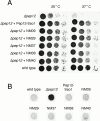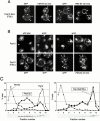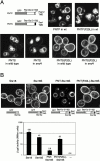A selective transport route from Golgi to late endosomes that requires the yeast GGA proteins
- PMID: 11062260
- PMCID: PMC2185592
- DOI: 10.1083/jcb.151.3.587
A selective transport route from Golgi to late endosomes that requires the yeast GGA proteins
Abstract
Pep12p is a yeast syntaxin located primarily in late endosomes. Using mutagenesis of a green fluorescent protein chimera we have identified a sorting signal FSDSPEF, which is required for transport of Pep12p from the exocytic pathway to late endosomes, from which it can, when overexpressed, reach the vacuole. When this signal is mutated, Pep12p instead passes to early endosomes, a step that is determined by its transmembrane domain. Surprisingly, Pep12p is then specifically retained in early endosomes and does not go on to late endosomes. By testing appropriate chimeras in mutant strains, we found that FSDSPEF-dependent sorting was abolished in strains lacking Gga1p and Gga2p, Golgi-associated coat proteins with homology to gamma adaptin. In the gga1 gga2 double mutant endogenous Pep12p cofractionated with the early endosome marker Tlg1p, and recycling of Snc1p through early endosomes was defective. Pep12p sorting was also defective in cells lacking the clathrin heavy or light chain. We suggest that specific and direct delivery of proteins to early and late endosomes is required to maintain the functional heterogeneity of the endocytic pathway and that the GGA proteins, probably in association with clathrin, help create vesicles destined for late endosomes.
Figures










Similar articles
-
Specific retrieval of the exocytic SNARE Snc1p from early yeast endosomes.Mol Biol Cell. 2000 Jan;11(1):23-38. doi: 10.1091/mbc.11.1.23. Mol Biol Cell. 2000. PMID: 10637288 Free PMC article.
-
Yeast Gga coat proteins function with clathrin in Golgi to endosome transport.Mol Biol Cell. 2001 Jun;12(6):1885-96. doi: 10.1091/mbc.12.6.1885. Mol Biol Cell. 2001. PMID: 11408593 Free PMC article.
-
Retromer and the sorting nexins Snx4/41/42 mediate distinct retrieval pathways from yeast endosomes.EMBO J. 2003 Feb 3;22(3):548-57. doi: 10.1093/emboj/cdg062. EMBO J. 2003. PMID: 12554655 Free PMC article.
-
The structure and function of GGAs, the traffic controllers at the TGN sorting crossroads.Cell Struct Funct. 2003 Oct;28(5):431-42. doi: 10.1247/csf.28.431. Cell Struct Funct. 2003. PMID: 14745135 Review.
-
The GGA proteins: key players in protein sorting at the trans-Golgi network.Eur J Cell Biol. 2004 Jul;83(6):257-62. doi: 10.1078/0171-9335-00374. Eur J Cell Biol. 2004. PMID: 15511083 Review.
Cited by
-
A microscopy-based kinetic analysis of yeast vacuolar protein sorting.Elife. 2020 Jun 25;9:e56844. doi: 10.7554/eLife.56844. Elife. 2020. PMID: 32584255 Free PMC article.
-
Distinct roles for TGN/endosome epsin-like adaptors Ent3p and Ent5p.Mol Biol Cell. 2006 Sep;17(9):3907-20. doi: 10.1091/mbc.e06-05-0410. Epub 2006 Jun 21. Mol Biol Cell. 2006. PMID: 16790491 Free PMC article.
-
Ent3p and Ent5p exhibit cargo-specific functions in trafficking proteins between the trans-Golgi network and the endosomes in yeast.Mol Biol Cell. 2007 May;18(5):1803-15. doi: 10.1091/mbc.e06-11-1000. Epub 2007 Mar 7. Mol Biol Cell. 2007. PMID: 17344475 Free PMC article.
-
GGAs: roles of the different domains and comparison with AP-1 and clathrin.Mol Biol Cell. 2001 Nov;12(11):3573-88. doi: 10.1091/mbc.12.11.3573. Mol Biol Cell. 2001. PMID: 11694590 Free PMC article.
-
Visualization of TGN to endosome trafficking through fluorescently labeled MPR and AP-1 in living cells.Mol Biol Cell. 2003 Jan;14(1):142-55. doi: 10.1091/mbc.e02-06-0338. Mol Biol Cell. 2003. PMID: 12529433 Free PMC article.
References
-
- Ausubel, F.M., R. Brent, R.E. Kingston, D.D. Moore, J.G. Seidman, J.A. Smith, and K. Struhl. 1995. Current Protocols in Molecular Biology. Vol. 1. J. Wiley and Sons, Inc., Boston, MA. 13.6.2–13.6.3.
Publication types
MeSH terms
Substances
LinkOut - more resources
Full Text Sources
Molecular Biology Databases

